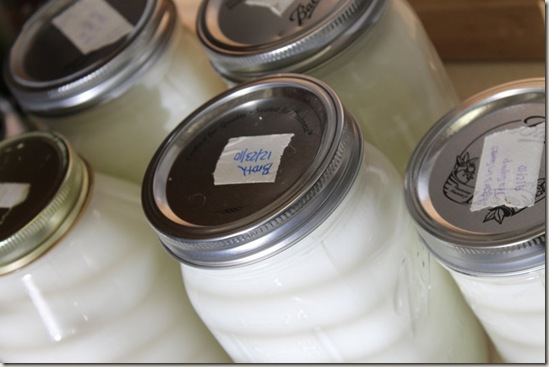I have been making my own yogurt for quite a while, and have posted about it here. I have yogurt pretty much every day, and usually will put some fruit or nuts in it to make it more interesting I use it in so many things! I love having it around, and you can pretty much always find it in my fridge!
This week in the Superfood Challenge, the subject is yogurt! Yesterday, I posted (unknowingly) about my homemade kefir, which is yogurts main sidekick! So, I guess I was ahead of the ball without even knowing it! :)
I have modified my yogurt recipe a little bit, so here it is updated for you My stomach issues continue, and I started wondering if adding the powdered milk to the yogurt was causing me a problem, so I decided to try the yogurt without it. I'm reminded that learning what makes me feel good is a continual battle, and what works for one person might not work for someone else!
I also had been adding ground flax seed to my yogurt each day, and it was turning out kind of slimy!! I usually prepare my yogurt at night, and then eat it for breakfast at work the next day. When I make a yogurt creation for my husband, add I some rolled oats on top. Since the oats had been bothering me, I started adding flax to the top of my yogurt as a substitute. But the slimy-ness really grossed me out! So, I decided to try adding chia seeds instead, and making a sort of chia pudding with the yogurt. It thickened it slightly, and turned out so yummy!

Homemade Yogurt, Take 2
1 gallon milk
1 cup yogurt
4 capsules probiotics
First, prepare your double boiler. I use 2 pans, one slightly bigger than the other. Fill the bottom pot with a couple inches of water.

Place the second pot inside this pot, and add the milk. Heat to 180 degrees.

Take 8 ounces of yogurt and place on the counter to cool to room temperature.

When the milk reaches 180, turn off the stove, and let cool to 110 degrees. (I have found the easiest and quickest way to do this is to place the milk in a sink full of cool water).

Preheat oven to 250 degrees. When the milk reaches 110 degrees, mix in the yogurt, stirring well. Add in the probiotic capsules as well.
Here are the priobiotics that I use.

Fill glass containers with the milk mixture. I used canning jars, and some other glass jars I had. I filled 4 quart jars, as well as 1 pint jar. Place lids on the jars, but leave loose (don't tighten all the way). Some places I have read state to NOT cover the jars with lids, but I have had jars get knocked over in the oven, so it gives me a little piece of mind that I won't have to clean up a mess in my oven. :)

Turn off the oven, and place a towel on the bottom rack. Place the jars on the towel, cover the jars well, or use another towel, and close the oven.

Leave in the oven overnight, or at least 8 hours.
Remove from the oven and place in the fridge.
Yield: 4 quart jars of yogurt, plus a little extra
I also had been adding ground flax seed to my yogurt, and it was turning out kind of slimy!! I usually prepare my yogurt at night, and then eat it for breakfast at work the next day. So, I decided to try adding chia seeds instead, and making a sort of chia pudding with the yogurt. It thickened it slightly, and turned out so yummy!

Jane's Chia Seed Yogurt
Print this recipe!
1 cup homemade yogurt, or any plain unsweetened yogurt
1 tbsp chia seeds
Any combination of fruit (I used 1/2 banana and 1 kiwi here)
Any nuts you would like (I used 2 tbsp chopped cashews)
Combine the chia seeds and yogurt, and place in refrigerator for at least 2 hours, or overnight. If you would like it sweeter, add some honey or other sweetener. Add in the fruit and nuts and eat up!

Yum!
I have been doing a lot of reading about how others make homemade yogurt, and I am a little confused! I tend to do that … over-research something and then just confuse myself!
I read here that you don't need to heat the milk to 180 degrees because that is essentially pasteurizing the milk, and the milk I buy is already pasteurized. Also, one the comments talked about the "starter yogurt" that you add in, and you should buy fresh yogurt from the store to ensure the cultures are "live and active". I have been using some yogurt from my last batch of homemade yogurt, and it has been fine. So it started me thinking … maybe I am not getting the good bacteria from the yogurt because of this? I do add probiotics so maybe I'm ok. Here it also talks about only heating the milk to 110, otherwise you can kill the "good" bacteria. Ahhh!!!!!
Also, this post and the comments have a lot of great information if your oven cannot hold the 110 degree temperature for an extended period of time. I have not had a problem with this! You can use heating pads, coolers, or even thermoses! No yogurt maker needed!
Bottom line, you have to do what YOU feel is right, and stop reading what other people are doing!
No comments:
Post a Comment